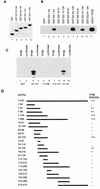Functional interaction of the bovine papillomavirus E2 transactivation domain with TFIIB
- PMID: 9444994
- PMCID: PMC124572
- DOI: 10.1128/JVI.72.2.1013-1019.1998
Functional interaction of the bovine papillomavirus E2 transactivation domain with TFIIB
Abstract
Induction of gene expression by the papillomavirus E2 protein requires its approximately 220-amino-acid amino-terminal transactivation domain (TAD) to interact with cellular factors that lead to formation of an activated RNA polymerase complex. These interaction partners have yet to be identified and characterized. The E2 protein localizes the transcription complex to the target promoter through its carboxy-terminal sequence-specific DNA binding domain. This domain has been reported to bind the basal transcription factors TATA-binding protein and TFIIB. We present evidence establishing a direct interaction between amino acids 74 to 134 of the E2 TAD and TFIIB. Within this region, the E2 point mutant N127Y was partially defective and W99C was completely defective for TFIIB binding in vitro, and these mutants displayed reduced or no transcriptional activity, respectively, upon transfection into C33A cells. Overexpression of TFIIB specifically restored transactivation by N127Y to close to wild-type levels, while W99C remained inactive. To further demonstrate the functional interaction of TFIIB with the wild-type E2 TAD, this region was fused to a bacterial DNA binding domain (LexA:E2:1-216). Upon transfection with increasing amounts of LexA:E2:1-216, there was reduction of its transcriptional activity, a phenomenon thought to result from titration of limiting factors, or squelching. Squelching of LexA:E2:1-216, or the wild-type E2 activator, was partially relieved by overexpression of TFIIB. We conclude that a specific region of the E2 TAD functionally interacts with TFIIB.
Figures




Similar articles
-
Bovine papillomavirus type 1 E2 transcriptional regulators directly bind two cellular transcription factors, TFIID and TFIIB.J Virol. 1995 Oct;69(10):6323-34. doi: 10.1128/JVI.69.10.6323-6334.1995. J Virol. 1995. PMID: 7666533 Free PMC article.
-
Conserved interaction of the papillomavirus E2 transcriptional activator proteins with human and yeast TFIIB proteins.J Virol. 1997 Oct;71(10):8041-7. doi: 10.1128/JVI.71.10.8041-8047.1997. J Virol. 1997. PMID: 9311902 Free PMC article.
-
The human immunodeficiency virus type 1 Vpr transactivator: cooperation with promoter-bound activator domains and binding to TFIIB.J Mol Biol. 1996 Sep 6;261(5):599-606. doi: 10.1006/jmbi.1996.0485. J Mol Biol. 1996. PMID: 8800208
-
Functional interaction of a novel cellular protein with the papillomavirus E2 transactivation domain.Mol Cell Biol. 1997 Dec;17(12):7208-19. doi: 10.1128/MCB.17.12.7208. Mol Cell Biol. 1997. PMID: 9372953 Free PMC article.
-
Mutational analysis of the D1/E1 core helices and the conserved N-terminal region of yeast transcription factor IIB (TFIIB): identification of an N-terminal mutant that stabilizes TATA-binding protein-TFIIB-DNA complexes.Mol Cell Biol. 1997 Dec;17(12):6784-93. doi: 10.1128/MCB.17.12.6784. Mol Cell Biol. 1997. PMID: 9372909 Free PMC article.
Cited by
-
The Papillomavirus E2 protein binds to and synergizes with C/EBP factors involved in keratinocyte differentiation.J Virol. 2003 May;77(9):5253-65. doi: 10.1128/jvi.77.9.5253-5265.2003. J Virol. 2003. PMID: 12692227 Free PMC article.
-
AMF-1/Gps2 binds p300 and enhances its interaction with papillomavirus E2 proteins.J Virol. 2000 Jul;74(13):5872-9. doi: 10.1128/jvi.74.13.5872-5879.2000. J Virol. 2000. PMID: 10846067 Free PMC article.
-
Tumor suppressor or oncogene? A critical role of the human papillomavirus (HPV) E2 protein in cervical cancer progression.Am J Cancer Res. 2011;1(3):373-389. Epub 2011 Jan 24. Am J Cancer Res. 2011. PMID: 21968515 Free PMC article.
-
Effect of bovine papillomavirus E2 protein-specific monoclonal antibodies on papillomavirus DNA replication.J Virol. 1999 Jun;73(6):4670-7. doi: 10.1128/JVI.73.6.4670-4677.1999. J Virol. 1999. PMID: 10233926 Free PMC article.
-
Interaction of papillomavirus E2 protein with the Brm chromatin remodeling complex leads to enhanced transcriptional activation.J Virol. 2007 Mar;81(5):2213-20. doi: 10.1128/JVI.01746-06. Epub 2006 Dec 6. J Virol. 2007. PMID: 17151122 Free PMC article.
References
-
- Androphy E J, Lowy D, Schiller J. Bovine papillomavirus E2 trans-activating gene product binds to specific sites in papillomavirus DNA. Nature (London) 1987;325:70–73. - PubMed
-
- Berger S L, Pina B, Silverman N, Marcus G A, Agapite J, Regier J L, Triezenberg S J. Genetic isolation of ADA2: a potential transcriptional adapter required for function of certain acidic activation domains. Cell. 1992;70:251–265. - PubMed
Publication types
MeSH terms
Substances
Grants and funding
LinkOut - more resources
Full Text Sources

